Ceasefire Violation in India: A Deep Dive into the Escalating Tensions
Ceasefire violations along the Line of Control (LoC) and International Border (IB) between India and Pakistan have been a persistent issue, leading to loss of lives, displacement of civilians, and heightened military tensions. Despite the 2003 ceasefire agreement, frequent breaches have raised concerns about regional stability. This article explores the causes, consequences, and geopolitical implications of ceasefire violations in India, while analyzing the latest developments and possible solutions.
Understanding Ceasefire Violations
A ceasefire violation occurs when either India or Pakistan breaches the terms of the 2003 agreement by engaging in cross-border firing, shelling, or infiltration attempts. These violations often result in casualties among security forces and civilians, exacerbating tensions between the two nuclear-armed neighbors.
Key Hotspots for Ceasefire Violations
Jammu & Kashmir (LoC & IB) – Poonch, Rajouri, Uri, and Kupwara are frequently affected.
International Border (IB) in Punjab & Rajasthan – Areas like Kathua and Samba witness sporadic clashes.
Recent Trends in Ceasefire Violations
Statistical Overview (2020-2024)
2020: Over 5,000 ceasefire violations reported, the highest in nearly two decades.
2021: A rare ceasefire reaffirmation in February led to a temporary decline.
2022-2023: Sporadic violations continued, with infiltration attempts rising.
2024: Increased shelling in Poonch and Rajouri, leading to civilian casualties.
Major Incidents in 2024
January 2024: Heavy mortar shelling in Kupwara, killing 2 soldiers and a civilian.
March 2024: Infiltration bid foiled in Uri, leading to a 12-hour gunfight.
May 2024: Cross-border firing in Rajouri displaces over 50 families.
Causes of Ceasefire Violations
1. Pakistan’s Proxy War Strategy
Pakistan-based militant groups like Lashkar-e-Taiba (LeT) and Jaish-e-Mohammed (JeM) frequently attempt infiltration, leading to Indian retaliation.
2. Political Instability in Pakistan
Internal turmoil in Pakistan often leads to increased ceasefire violations as a diversionary tactic.
3. India’s Strong Counter-Infiltration Measures
India’s robust border surveillance (using drones, thermal imaging, and fencing) forces Pakistan to escalate firing to aid infiltrators.
4. Geopolitical Tensions
Issues like Kashmir’s special status abrogation (Article 370) and FATF pressures on Pakistan contribute to flare-ups.
Impact of Ceasefire Violations
1. Humanitarian Crisis
Civilian deaths & injuries – Innocent villagers bear the brunt.
Displacement – Thousands migrate to safer zones, disrupting livelihoods.
2. Economic Losses
Farmland destruction – Shelling damages crops and livestock.
Border infrastructure costs – Reinforced bunkers and surveillance tech require heavy investment.
3. Military Strain
Increased deployment – Soldiers remain on high alert, leading to fatigue.
Escalation risks – Any major incident could trigger a larger conflict.
India’s Response to Ceasefire Violations
1. Diplomatic Measures
Strong protests at UN & bilateral forums
Global isolation of Pakistan over terrorism
2. Military Retaliation
"Surgical Strikes" (2016 & 2019) – Preemptive strikes on terror launchpads.
Heavy retaliatory firing – Matching Pakistan’s aggression.
3. Technological Upgrades
Smart fencing & laser walls along LoC
Drone surveillance & AI-based monitoring
International Reactions
United States: Urges restraint but holds Pakistan accountable for terrorism.
China: Calls for dialogue but avoids direct criticism of Pakistan.
Russia & EU: Advocate peaceful resolution under UN frameworks.
Can a Permanent Ceasefire Be Achieved?
Challenges
Pakistan’s deep-state support to militants
Kashmir remains a contentious issue
Lack of trust between armies
Possible Solutions
Third-party mediation (UN or neutral nations)
Strengthening confidence-building measures (CBMs)
Economic incentives for peace
Conclusion
Ceasefire violations between India and Pakistan remain a volatile issue with severe humanitarian and security consequences. While temporary lulls occur, a lasting solution requires Pakistan to dismantle terror infrastructure and both nations to engage in meaningful dialogue. Until then, India must continue its defensive and diplomatic efforts to safeguard its borders and citizens.
SEO Optimized Keywords
Ceasefire violation India 2024
India Pakistan border clash latest news
LoC ceasefire violations impact
Indian Army retaliation Pakistan firing
Kashmir ceasefire agreement updates
By addressing the root causes and exploring diplomatic solutions, India can mitigate the risks of further escalation while ensuring regional stability. Stay updated with verified sources for real-time developments on this critical issue.

Comments
Post a Comment